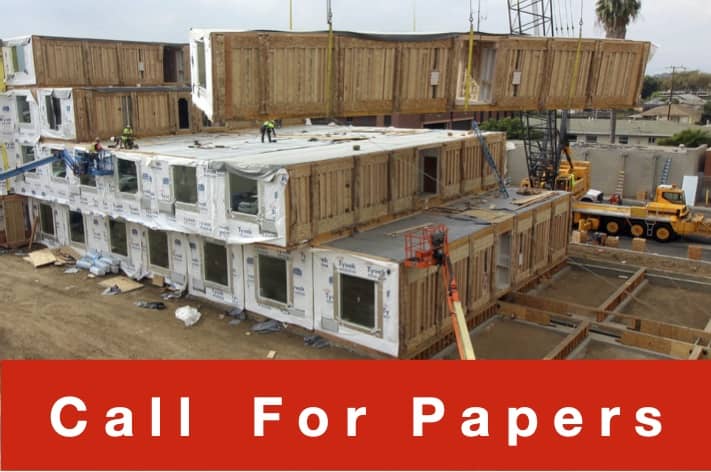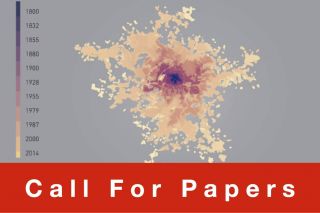
www.buildingsandcities.org/calls-for-papers/cfp-mmc.html
Modern Methods of Construction: Beyond Productivity Improvement

Guest Editor: Stuart D. Green (University of Reading)
Abstract submissions closed on 13 SEPTEMBER 2021
What are the potential unintended consequences of modern methods of construction which are not currently considered?
This special issue investigates the externalities of modern methods of construction (MMC). It examines the dominant narrative used to promote MMC. Although an increased proportion of pre-manufactured value (PMV) may improve narrowly-defined site-based 'productivity', evidence is needed on the associated externalities and potential long-term adverse systemic consequences. What can be learned from previous attempts to modernise the construction process with industrialised methods?
Aim
The aim of this special issue is to examine the assumptions underpinning the prevailing 'presumption in favour' of MMC. Contributions will provide evidence about the externalities which lie beyond the narrowly-defined construct of productivity. Priority will be given to empirical papers aimed at exploring the systemic consequences of an ever-increasing proportion of PMV in construction. The special issue is open to a range of quantitative and qualitative research methods using primary and/or secondary data. Contextualised case studies are especially welcome.
Background
Modern methods of construction (MMC) are seemingly the latest panacea of industry improvement (BSA, 2016, HM Government, 2020; NAO, 2005; NHBC Foundation, 2018; RICS, 2016). The core message is that the construction sector must modernise or die (cf. Farmer, 2016). Yet the extent to which MMC is indeed 'modern' is at best contestable; its antecedents are arguably evident in the 1851 construction of the Crystal Palace exhibition hall in London. The Scandinavian tradition of prefabricated housing can be traced back to the Vikings (Price, 2020). More recent variants include industrialised building (Diamant, 1965; Dietz and Cutler, 1971), system building (Finnimore, 1989; Grindrod, 2013) and offsite prefabrication (Gibb, 1999; Pan et al., 2007). The popularity of such methods notably ebbs and flows over time, with as many recorded failures as there are successes (Gibb, 2001). Significant uptake has traditionally been dependent upon unique and short-lived, local imperatives which serve to outweigh the risks of the additional up-front capital investment (Rosenfeld, 1994). State subsidies have often played an important role in enabling industrialised methods to flourish, only for their use to decline when the subsidy is withdrawn (cf. Blanchet and Zhuravlyova, 2018; Boughton, 2018). Notable failures such as Ronan Point (1968) have also been important in denting public confidence.
Despite the above chequered history, MMC is being promoted as a solution to the perceived failings of the construction sector. The narrative is notably characterised by a strong pro-innovation bias. The current advocacy of MMC derives its broader legitimacy from the discourse of the Fourth Industrial Revolution (cf. McKinsey, 2016; Schwab, 2016). Dissenters are consistently cast in a negative role, with little recourse to evidence-based research.
Beyond productivity improvement
The definition of MMC remains problematic, but an emerging consensus is that MMC is best understood on the basis of pre-manufactured value (PMV) - i.e. the proportion of offsite construction as a percentage of the total measured works. But as yet there is little research which extends beyond the traditional drivers of time, cost, quality and productivity (cf. Pan et al., 2007). Much of the research which does exist comprises opinion surveys on levels of adoption, and perceived barriers to implementation (cf. Goodier and Gibb, 2007; Rahman, 2014; Pan and Sidwell, 2011). What remains largely unexplored are the temporal externalities which extend beyond the construction phase. Little evidence exists on the implications of MMC for the material fabric of the built environment. There is also a recurring reluctance to learn the lessons of the past. This is of particular concern within the context of housing, although it applies equally to other sectors. In 1984, Geoffrey Lofthouse MP famously presented the following question during a UK parliamentary debate on defects in systems-built housing:
"We must also ask whether sufficient time and money is spent in appraising new methods of building, and new components and materials. As an example, the Agrément certificate procedure is very weak, and gives little real assessment of how building will work out in practice.There is virtually no long-term monitoring of buildings" (Hansard, 12 March 1984).
Scant research and data exist on the implications of MMC for the performance and longevity of buildings, and their ability to respond over time to shifting societal and occupant needs. The durability and adaptability of buildings are of central importance for resource consumption and for the achievement of a net-zero carbon economy. Particular concerns relate to environmental performance and occupant wellbeing After London's Grenfell Tower fire, there are also significant concerns regarding the implications of MMC for fire safety (Davis, 2019)
Notwithstanding the above, any significant increase in the proportion of PMV is also likely to have systemic consequences for the economic structure of the sector. Particular concerns relate to employment practices and the potentially adverse implications for skills within local communities. The increasing emphasis on PMV further exposes the construction sector to competition from global manufacturing firms, with significant implications for the barriers to entry and the national balance of payments. Additional questions relate to lack of transparency in global supply chains, with direct implications for the risk of labour exploitation (Allain et al., 2013). Outsourcing sub-assembly processes to geographically remote locations can reduce standards of environmental protection.
Suggested topics
Business models: What lessons can be learnt from previous attempts to stimulate industrialised construction through alternative business models? To what extent have such previous initiatives relied on state support to alleviate fluctuations in the business cycle? How successful were they in terms of achieving productivity improvement while maintaining an appropriate baseline of quality? By what means have previous schemes aimed at incentivising industrialised construction succeeded in particular market niches? What are the key measures that could usefully be introduced to ensure that the mistakes of the past are not replicated?
Macro-economic implications: What impact would an increased proportion of PMV have on the economic structure of the construction sector and its supply chains? What are the implications of MMC for employment practices, supply chain resilience and the global mobility of migrant workers? What are the implications of a globalised supply chain on the imbalance between imports and exports, i.e. the national balance of payments? What are the cash flow implications of an increase in PMV for clients and contractors? What are the knock-on consequences for lifecycle ownership costs? What is the evidence that MMC improves housing affordability?
Environmental impacts: What is the through-life environmental performance of buildings comprising different levels of PMV - especially the relationship between building longevity and embodied carbon (cf. Monahan and Powell, 2011; Pomponi and Moncaster, 2016)? What are environmental consequences of transporting large prefabricated components across global supply chains? Further issues relate to the thermal performance of buildings comprising modular volumetric construction, and the associated risks of overheating in summer or, alternatively, fostering an increased dependency on air conditioning.
Building fabric: What is the relationship between MMC and the long-term durability of the building fabric? What lessons arise from previous industrialisation initiatives? To what extent are pre-fabricated components malleable to accommodate change over the service life of MMC buildings, and future retrofits? If MMC buildings have shorter lifespans, what are the economic and social consequences of the shorter replacement cycle?
Quality and liability: Who carries the liability for poor quality/performance e.g. fire safety, durability and fitness for purpose? What warranties and protection cascade down to tenants and leaseholders, especially in the context of globalised supply chains?
Governance: What additional governance arrangements are needed for regulating and evaluating increasingly globalised supply chains? How are the increased risks from mass production assessed and dealt with for a problem that may affect thousands of buildings? What are the implications for consumer protection for the various parties involved i.e. tenants, leaseholders and freeholders? What are the implications for through-life building stewardship? What is needed to address the lack of transparency within global supply chains about labour practices and exploitation?
Employment and skills: What are the long-term consequences of MMC for the skills available in local communities? Of particular importance are the skills necessary for maintaining and retrofitting the existing building stock. What are the long-term implications of MMC for employment practices?
Briefing Note for Contributors
You are invited to submit an abstract for a journal paper in this special issue of Buildings & Cities. In the first instance, please send a 500 word (maximum) abstract defining the scope, methods and results to Richard Lorch richard@rlorch.net by 13 SEPTEMBER 2021. The initial abstract submission must include:
- the author's and all co-author's names, affiliations and contact details
- the question(s) and topics in this Call for Papers that the abstract and intended paper addresses
- the abstract (300 - 500 words maximum) which should include a description of methods and key findings
Abstracts will be reviewed by the editors to ensure a varied, yet integrated selection of papers around the topic of the special issue. Authors of accepted abstracts will be invited to submit a full paper which then undergoes a double-blind peer review process. The journal publishes the several different types of papers: research, synthesis, policy analysis, methods, & replication, see: https://bit.ly/3n0mIIz
Timeline
Deadline for abstract submission: 13 September 2021
Full papers due: 01 February 2022
Referees' comments 29 March 2022
Final version due 27 May 2022
Publication July 2022 (NB: papers are published as soon as they are accepted)
Buildings & Cities journal
Buildings & Cities is an international, open access, not-for-profit, double-blind peer-reviewed research journal. Its focus is the interactions between buildings, neighbourhoods and cities by understanding their supporting social, economic and environmental systems. More information including its Aims & Scope, Key Principles and Editorial Board can be found online: www.buildingsandcities.org.
Buildings & Cities is an open access journal and has an article processing charge of £1200 (plus VAT if applicable). If you do not have institutional support, please contact the editor to discuss. We endeavour to assist those without funding to publish in our journal.
Questions?
If you have a question, please contact: Richard Lorch and Stuart Green
References
Allain, J., Crane, A., LeBaron, G. and Behbahan, L. (2013). Forced Labour's Business Models and Supply Chains. York: Joseph Rowntree Foundation.
Blanchet, E. and Zhuravlyova, S. (2018). Prefabs: A Social and Architectural History. Swindon: Historic England.
Boughton, J. (2018). Municipal Dreams: The Rise and Fall of Council Housing. London: Verso.
Building Societies Association (BSA) (2016). Laying the Foundations for MMC. London: BSA.
Davis, D. (2019). Risks of increasing use of modern methods of construction, Fire Magazine, 114(1416) www.fire-magazine.com/risks-of-increasing-use-of-modern-methods-of-construction
Diamant, R. M. E. (1964). Industrialised Building: 50 International Methods. London: IIiffe Books.
Dietz, A. G. M. and Cutler, A. S. (eds.) (1971). Industrialized Building Systems and Housing. Cambridge, MA: MIT Press
Farmer, M. (2016). The Farmer Review of the UK Construction Labour Model: Modernise or Die. London: Construction Leadership Council.
Finnimore, B. (1989). Houses from the Factory: System Building and the Welfare State 1942-74. London: Rivers Oram Press.
Gibb, A. G. F. (1999). Off-site Fabrication: Prefabrication, Pre-assembly and Modularisation. New York: Wiley.
Gibb, A. G. F. (2001). Standardization and pre-assembly - distinguishing myth from reality using case study research, Construction Management and Economics, 19(3), 307-315.
Goodier, C. and Gibb, A. (2007). Future opportunities for offsite in the UK, Construction Management and Economics, 25(6), 585-595.
Grindrod, J. (2013). Concretopia: A Journey Around the Rebuilding of Postwar Britain. London: Old Street Publishing.
HM Government (2020). The Construction Playbook: Government guidance on sourcing and contracting public works projects and programmes. London: Cabinet Office.
McKinsey (2016). Industry 4.0 after the initial hype: where manufacturers are finding best value and how they can best capture it. McKinsey & Co.
Monahan, J. and Powell, J. C. (2011). An embodied carbon and energy analysis of modern methods of construction in housing: A case study using a lifecycle assessment framework, Energy and Buildings, 43(1), 179-188.
National Audit Office (NAO) (2005). Using modern methods of construction to build homes more quickly and efficiently. London: NAO.
NHBC Foundation (2018). Modern Methods of Construction: Who's Doing What? Milton Keynes: NHBC Foundation.
Pan, W., Gibb, A. D. F. and Dainty, A. R. J. (2007). Perspectives of UK housebuilders on the use of offsite modern methods of construction, Construction Management and Economics, 25(2), 183-194.
Pan, W. and Sidwell, R. (2011). Demystifying the cost barriers to offsite construction in the UK, Construction Management and Economics, 29:11, 1081-1099.
Pomponi, F. and Moncaster, A. (2016). Embodied carbon mitigation and reduction in the built environment: What does the evidence say? Journal of Environmental Management, 181(1) 697-700.
Price, N. (2020). Children of Ash and Elm: A History of the Vikings. London: Allen Lane.
Rahman, M.M. (2013). Barriers of implementing modern methods of construction, J of Management in Engineering 30(1) 69-77.
Rosenfeld, Y. (1994). Innovative construction methods, Construction Management and Economics, 12(6) 521-541.
Royal Institution of Chartered Surveyors (RICS) (2018). Modern Methods of Construction: A Forward-Thinking Solution to the Housing Crisis? London: RICS
Schwab, K. (2016). The Fourth Industrial Revolution. Davos: World Economic Forum.
Latest Peer-Reviewed Journal Content
Youth engagement in urban living labs: tools, methods and pedagogies
N Charalambous, C Panayi, C Mady, T Augustinčić & D Berc
Co-creating urban transformation: a stakeholder analysis for Germany’s heat transition
P Heger, C Bieber, M Hendawy & A Shooshtari
Placemaking living lab: creating resilient social and spatial infrastructures
M Dodd, N Madabhushi & R Lees
Church pipe organs: historical tuning records as indoor environmental evidence
B Bingley, A Knight & Y Xing
A framework for 1.5°C-aligned GHG budgets in architecture
G Betti, I Spaar, D Bachmann, A Jerosch-Herold, E Kühner, R Yang, K Avhad & S Sinning
Net zero retrofit of the building stock [editorial]
D Godoy-Shimizu & P Steadman
Co-learning in living labs: nurturing civic agency and resilience
A Belfield
The importance of multi-roles and code-switching in living labs
H Noller & A Tarik
Researchers’ shifting roles in living labs for knowledge co-production
C-C Dobre & G Faldi
Increasing civic resilience in urban living labs: city authorities’ roles
E Alatalo, M Laine & M Kyrönviita
Co-curation as civic practice in community engagement
Z Li, M Sunikka-Blank, R Purohit & F Samuel
Preserving buildings: emission reductions from circular economy strategies in Austria
N Alaux, V Kulmer, J Vogel & A Passer
Urban living labs: relationality between institutions and local circularity
P Palo, M Adelfio, J Lundin & E Brandão
Living labs: epistemic modelling, temporariness and land value
J Clossick, T Khonsari & U Steven
Co-creating interventions to prevent mosquito-borne disease transmission in hospitals
O Sloan Wood, E Lupenza, D M Agnello, J B Knudsen, M Msellem, K L Schiøler & F Saleh
Circularity at the neighbourhood scale: co-creative living lab lessons
J Honsa, A Versele, T Van de Kerckhove & C Piccardo
Positive energy districts and energy communities: how living labs create value
E Malakhatka, O Shafqat, A Sandoff & L Thuvander
Built environment governance and professionalism: the end of laissez-faire (again)
S Foxell
Co-creating justice in housing energy transitions through energy living labs
D Ricci, C Leiwakabessy, S van Wieringen, P de Koning & T Konstantinou
HVAC characterisation of existing Canadian buildings for decarbonisation retrofit identification
J Adebisi & J J McArthur
Simulation and the building performance gap [editorial]
M Donn
Developing criteria for effective building-sector commitments in nationally determined contributions
P Graham, K McFarlane & M Taheri
Join Our Community

The most important part of any journal is our people – readers, authors, reviewers, editorial board members and editors. You are cordially invited to join our community by joining our mailing list. We send out occasional emails about the journal – calls for papers, special issues, events and more.
We will not share your email with third parties. Read more



Latest Commentaries
COP30 Report
Matti Kuittinen (Aalto University) reflects on his experience of attending the 2025 UN Conference of the Parties in Belém, Brazil. The roadmaps and commitments failed to deliver the objectives of the 2025 Paris Agreement. However, 2 countries - Japan and Senegal - announced they are creating roadmaps to decarbonise their buildings. An international group of government ministers put housing on the agenda - specifying the need for reduced carbon and energy use along with affordability, quality and climate resilience.
Building-Related Research: New Context, New Challenges
Raymond J. Cole (University of British Columbia) reflects on the key challenges raised in the 34 commissioned essays for Buildings & Cities 5th anniversary. Not only are key research issues identified, but the consequences of changing contexts for conducting research and tailoring its influence on society are highlighted as key areas of action.